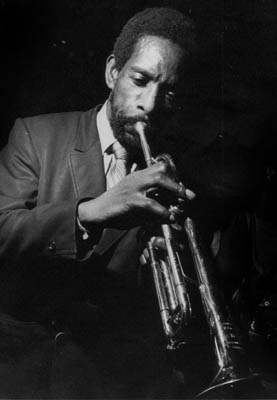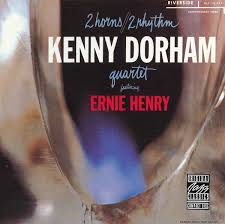Jazz-Classic – Kenny Dorham
As the title implies, this charming song has a classical or baroque influence. Originally recorded with a chordless quartet lineup, it's available here as a Condensed Score (which is also the rhythm section part), 1st and 2nd horn parts.
- Recording: Kenny Dorham - 2 Horns / 2 Rhythm
- Recorded on: December 2, 1957
- Label: Riverside (RLP 12-255)
- Concert Key: A-flat
- Vocal Range: , to
- Style: Swing (medium up)
- Trumpet - Kenny Dorham
- Alto Sax - Ernie Henry
- Bass - Wilbur Ware
- Drums - Wilbert Granville T. Hogan
Video
- Description
- Historical Notes
- Solos
- Piano Corner
- Bass Corner
- Drum Corner
- Guitar Corner
- Inside & Beyond
- Minus You
Kenny Dorham's signature melodic lyricism is on display in Jazz-Classic, a charming miniature with almost a classical or baroque sound. The 32-measure head is divided into 16-measure A and B sections, which start the same but go in different directions after the first six measures. Harmonically, Jazz-Classic tells a complete story; mostly diatonic with each section beginning on F minor with a "walk down" leading to A♭ major, plus a little modulation to B major toward the end of A. Solos are on an unusual, truncated version of the head form: two sections similar to A and B, but only 14 measures each going cyclically into the next section or chorus.
About the arrangement: The two horns begin unison with a little harmony, but go into some baroque-esque counterpoint at B. On the head, the bass line is nearly through-composed—especially important in the chordless quartet setting on the recording. The bass plays whole and half notes on A and quarter notes on B, but only for the middle of B is the bass truly walking; this is the only part of the head with chord symbols shown. The drums are really playing the same as the bass: cymbal half notes on A, going to quarter notes on B.
This song is really written for a chordless lineup. Besides first and second horn parts we have a 2-staff Condensed Score, with horns on the top staff and bass on the bottom staff; this is also the rhythm section part.
About the arrangement: The two horns begin unison with a little harmony, but go into some baroque-esque counterpoint at B. On the head, the bass line is nearly through-composed—especially important in the chordless quartet setting on the recording. The bass plays whole and half notes on A and quarter notes on B, but only for the middle of B is the bass truly walking; this is the only part of the head with chord symbols shown. The drums are really playing the same as the bass: cymbal half notes on A, going to quarter notes on B.
This song is really written for a chordless lineup. Besides first and second horn parts we have a 2-staff Condensed Score, with horns on the top staff and bass on the bottom staff; this is also the rhythm section part.
For another song from "Two Horns /Two Rhythm" check out Lotus Blossom, from an earlier session with Eddie Mathias on bass. These sessions were the last recordings of alto saxophonist Ernie Henry, who died at age 31 at the end of December 1957. Both Kenny Dorham and bassist Wilbur Ware had played on Henry's first album as a leader, "Presenting Ernie Henry," also on Riverside.
Related Songs
Email Send Jazz-Classic to a friend
Send this page to a friend via email. Add your name or email in the first field. In the second, add one or more email addresses, separated by a comma.

Kenny Dorham
August 30, 1924 – December 15, 1972
August 30, 2025, is Kenny Dorham's 101st birthday: jazzleadsheets.com has added many new K.D. compositions. Jazz At Lincoln Center has dedicated three late-night sets to Kenny's music, played with love by young musicians who want his music to live on. Join in, play K.D. music! Read more...
There was a problem.
...

